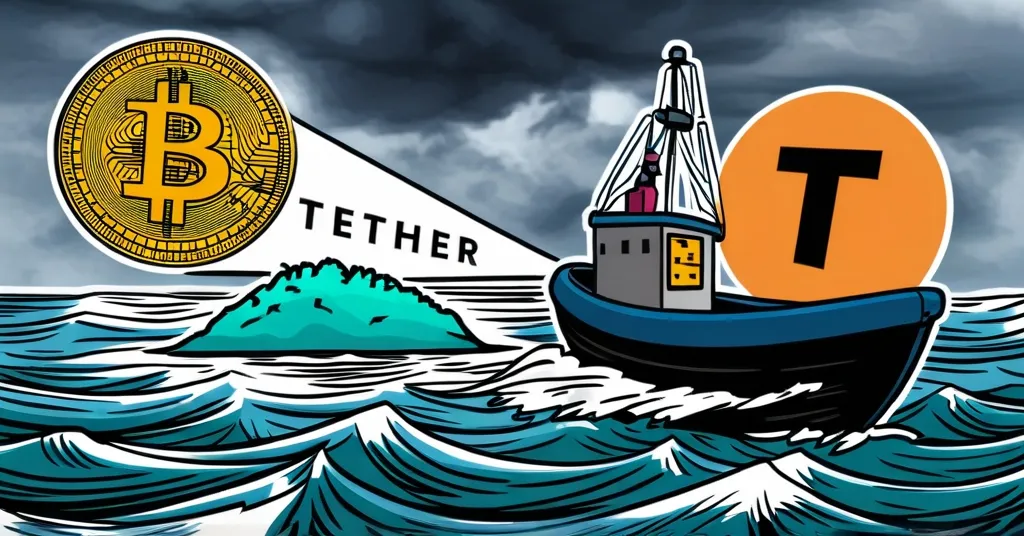Tether Bolsters Bitcoin Reserves by $700M Amid EU Regulatory Storm

Tether Boosts Bitcoin Reserves with $700 Million Transfer Amid Regulatory Challenges
In a bold move amidst regulatory storms, Tether has transferred a staggering $700 million in Bitcoin to its reserves. This strategic maneuver highlights Tether’s commitment to steering the Bitcoin wave with a $700 million paddle.
- Tether transferred 7,629 BTC to its reserve
- Largest transaction since March 2024
- Facing challenges with MiCA regulation in Europe
- USDT market cap dropped by $2 billion
Tether, the powerhouse behind the USDT stablecoin—a type of cryptocurrency designed to maintain a stable value, often pegged to a fiat currency like the US dollar—recently transferred 7,629 BTC from its online wallet at Bitfinex to its Bitcoin reserve. This move, valued at approximately $700 million, marks the largest such transaction since March 2024 and reflects Tether’s ongoing strategy to diversify its assets. Diversification means Tether is spreading its investments across different types of assets to reduce risk. Since May 2023, Tether has been allocating up to 15% of its profits into Bitcoin, growing its reserve from an initial purchase of $2.99 billion to a current valuation of $7.68 billion with 82,983 BTC. This strategy shows Tether’s confidence in Bitcoin, which doubled in price in 2024 and reached an all-time high of around $108,000 in mid-December.
While Tether’s Bitcoin strategy is clear, the regulatory environment presents significant challenges. The Markets in Crypto Assets (MiCA) regulation, designed to standardize crypto operations in the EU, is stirring up concerns about potential delisting from centralized exchanges in the region. Tether’s CEO, Paolo Ardoino, has been vocal about these ambitions, yet the regulatory storm has already contributed to a $2 billion drop in USDT’s market cap over the past week, bringing it down from $140.5 billion to $138 billion. It’s a reminder that even the most dominant players in the crypto space aren’t immune to the whims of regulators.
Despite these challenges, Tether isn’t just stacking sats; they’re building a digital Fort Knox. CEO Paolo Ardoino has announced plans to expand beyond stablecoins into sectors like artificial intelligence, Bitcoin mining, and decentralized communications. This diversification strategy is commendable and reflects Tether’s commitment to innovation and building technology solutions that promote freedom, independence, and resilience. Ardoino’s vision for an AI platform debut in Q1 2025 showcases Tether’s ambition to not only survive but thrive in the ever-changing crypto landscape.
Tether’s move to bolster its Bitcoin reserves amidst regulatory headwinds could be seen as a vote of confidence in the long-term potential of Bitcoin. As more companies like KULR Technology Group and Quantum BioPharma add Bitcoin to their balance sheets, Tether’s strategy aligns with a broader trend of institutional interest in the cryptocurrency.
The regulatory landscape is becoming increasingly complex. MiCA’s stringent requirements could push smaller crypto firms out of the EU due to compliance costs, potentially leading to market consolidation. Italy’s planned increase in capital gains tax on crypto assets from 26% to 42% further reflects a shift toward treating cryptocurrencies as mainstream financial instruments subject to standard tax regulations.
Agne Linge, WeFi Head of Growth, notes that meeting MiCA’s reserve and liquidity mandates could be economically challenging for Tether. However, she believes that Tether’s large market capitalization and global adoption insulate it from immediate financial consequences. Meanwhile, Uldis Teraudkalns, Paybis Chief Revenue Officer, highlights that MiCA could drive both smaller and larger firms out of the EU, potentially benefiting near-EU jurisdictions like the UK and Switzerland.
Beyond the regulatory hurdles, Tether’s ambitions in AI are noteworthy. CEO Paolo Ardoino’s plan for an AI platform debut in Q1 2025 showcases Tether’s commitment to innovation and its focus on building technology solutions that promote freedom, independence, and resilience.
As Tether navigates these turbulent waters, it’s clear that the company is playing a high-stakes game. Its move to increase Bitcoin reserves is a bold statement of faith in the future of cryptocurrencies, even as it faces down regulatory challenges that could reshape the industry.
Key Takeaways and Questions
- What is the significance of Tether’s recent Bitcoin transfer?
Tether’s transfer of 7,629 BTC to its reserve is significant as it represents the largest such transaction since March 2024, reflecting the company’s strategy to bolster its Bitcoin holdings as part of a broader diversification effort.
- How has Tether’s Bitcoin reserve grown over time?
Since May 2023, Tether has been allocating up to 15% of its profits into Bitcoin, resulting in a current reserve of 82,983 BTC, valued at $7.68 billion. This reserve was initially purchased for $2.99 billion, indicating substantial growth in value.
- What sectors is Tether looking to expand into?
Tether, under the leadership of CEO Paolo Ardoino, is exploring opportunities in artificial intelligence, Bitcoin mining, and decentralized communications, aiming to diversify its business ventures beyond stablecoins.
- What are the current concerns surrounding Tether’s USDT?
The implementation of the MiCA regulation in Europe has raised concerns about the potential delisting of USDT from centralized exchanges in the region, contributing to a $2 billion drop in its market cap over the past week.
- How is the MiCA regulation affecting Tether’s operations?
While the MiCA regulation may force Tether to exit centralized exchanges in the EU, USDT will still be available on decentralized exchanges (DEXs) and peer-to-peer (P2P) platforms, mitigating some of the impact.



